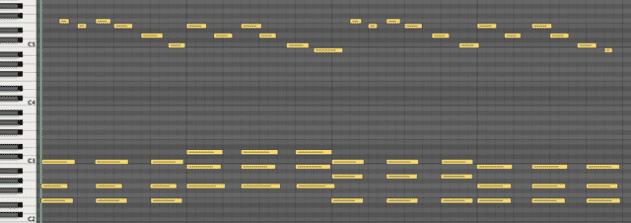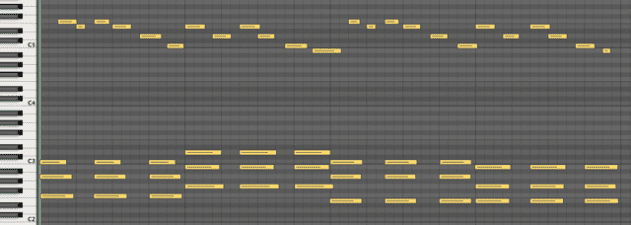Hans Zimmer
For a very different example of the same technique in use, check out ‘Time’ from Hans Zimmer’s brilliant soundtrack to the movie Inception:
Similarly to a lot of main room tracks, ‘Time’ uses variations on a repeating chord progression, this time in E minor:
A minor – E minor – G major – D major – A minor – C major 7 – G major – D major
Listen to the effect produced by the C major 7, each time adding a huge sense of anticipation and emotion to the piece. For want of a less cliched word, this chord contributes hugely to the ‘epic’ feel of the track.
In My Mind
We can hear another good example in Ivan Gough and Feenixpawl’s track ‘In My Mind’:
Again, the track uses a simple repeating melody over the top of a chord progression in the key of G minor. The progression opens with the sixth chord in G minor: Eb major.
Although far from being a hard and fast rule in writing chord progressions, we can hear how effective the use of the sixth chord of a scale can be in adding to the emotion in a track, especially when used in conjunction with an ostinato.
Variations on a Theme
Finally, let’s look at an example of how we could put this technique into practice. Below are two variations on a simple main room-style progression in A minor, played using a piano sound for clarity.
The first time through, each loop opens on a C major chord. We can hear how the sense of anticipation is increased in the second variation by the use of the F major chord in place of the C major.
This very basic technique of writing 4-bar or 8-bar chord progressions using notes from the natural minor scale – with judicious application of the sixth chord of the scale – is one of the easiest ways to create big, emotional main room tracks.




03.54 PM
Not my type of music at all but soem quite interesting ideas in this tutorial. Going to try experimenting with that idea of the Amin triad being the top notes of the Fmaj7 chord. Might work nicely to hold those notes then alternate between the F and the G or switch between A and F in the bass.
10.29 AM
nice article!
especially in the Hans Zimmer track it’s incredible how the change of one single chord lifts up the hole track/progression.
08.04 PM
good article! but is this really anything new when you think about it? music theory hasn’t changed in a long time, and the feelings that certain chord progressions haven’t changed much either (besides the sound/timbre/etc of the sound). i think the great artists are the ones who are masters of blending this classical knowledge with cutting-edge sound creation and production. also i love the example of the hans zimmer track… a great soundtrack can capture an abstract feeling indescribably well.
01.10 AM
hey spencer: why does it have to be new?
Its new to me!
02.38 PM
Interpreting the Inception track that way makes a lot of sense, and explains the effect of the Cmaj7 chord, but doesn’t it sound like the key center is A rather than E? In which case the lifting effect could be explained by the jump to the b in the melody and the tension between he b and c notes.
06.26 PM
Hey Fogworth,
The key centre sounds very strongly to be E minor (or G major) to me. In my opinion, one of the most powerful things about this particular chord progression is the fact that it doesn’t start or end on its tonic / key centre.
Also, from a theoretical perspective, if the key was A minor, the D chord would most likely be a D minor rather than a D major.
Either way, I’d certainly agree that both the tension between the B and the C in the C major 7 chord and the distance / dissonance between the C and B in the melody, are hugely effective.
Cheers!
Oliver
09.54 AM
Great tips!
10.39 PM
Another fantastic article that has explained things to me in a way that I can finally understand. So glad I’ve stumbled upon this site!
Great work guys!!
09.25 AM
GreatArticles on this magazine at all! Nice onnection between theory and practicing! Could you make an explanation on these really heavy electro Kickdrums?Basically its clear that its a kick with a sine wave behind it but it never fits as it should, so maybe you awesome guys can fix that lack of knowledge!
Cheers!
11.54 PM
As a guitar player coming to electronic music I find these passing notes articles really useful. Thank you, keep them
coming
03.12 PM
very nice thanxs!
07.55 PM
Hii….Can anybody help me with the 6th chord..whats exactly the 6th chord of a scale??
07.36 PM
Awesome! Thanks for the help xD
11.56 PM
Marc, the 6th chord is just the 6th note of a scale made into a triad chord “1st-3rd-5th”. In A minor , or most scales the 6th chord is played as a minor chord where the 3rd is played a half step down. Triads are made using FACEGBDFA …. . Take any note there and the two to the right make a triad. In these piano rolls they are inverted. So the root note or 1st note may be payed above the other notes in the chord. Chord charts are made up of the number from the scale.
scale of A minor
A B C D E F G A
1 2 3 4 5 6 7 8
This article might have been greatly simplified if it summarized each example with a chord chart and stated the chords in each piano roll instead of just the picture. As i see it , and please don’t quote me, I just glanced through them , but on page one the example is A minor scale
A B C D E F G A
1 2 3 4 5 6 7 8
and piano roll show
F G A E , F E D D
or
6-7-1-5, 6-5-4-4
and the final example also in A minor is :
C G A E, F G A E
or
3 -7-1-5, 6-7-1-5
The Hans Zimmer example would be :
Eminor
E F G A B C D E
1 2 3 4 5 6 7 8
A minor – E minor – G major – D major, then … A minor – C major 7 – G major – D major
or
4-1-3-7, 4-6-3-7
For melody while each chord is playing, use the notes from that chord to make the melody and use passing tones as well.